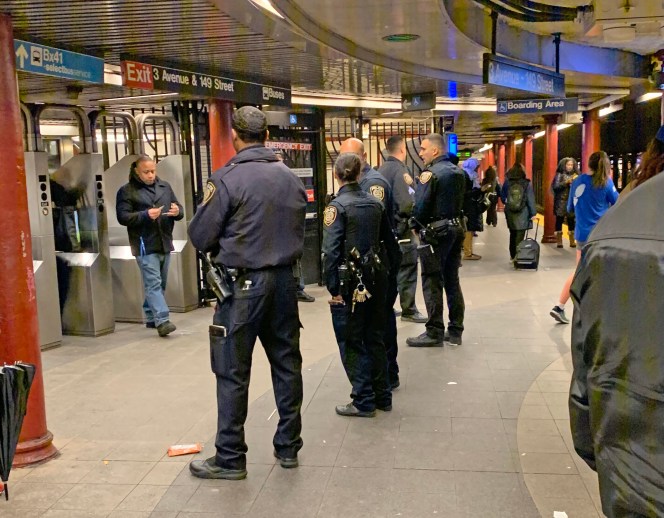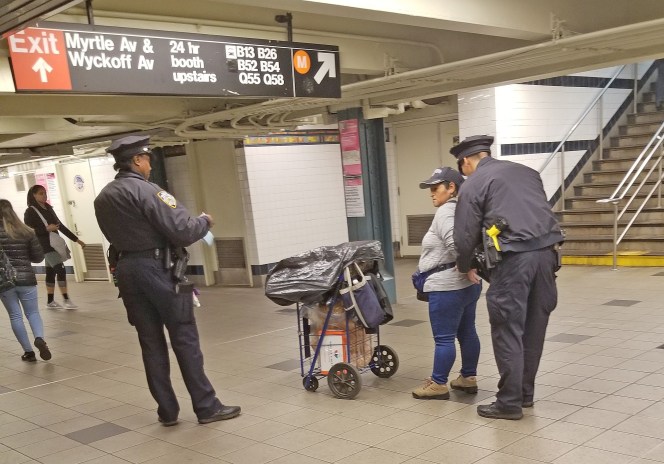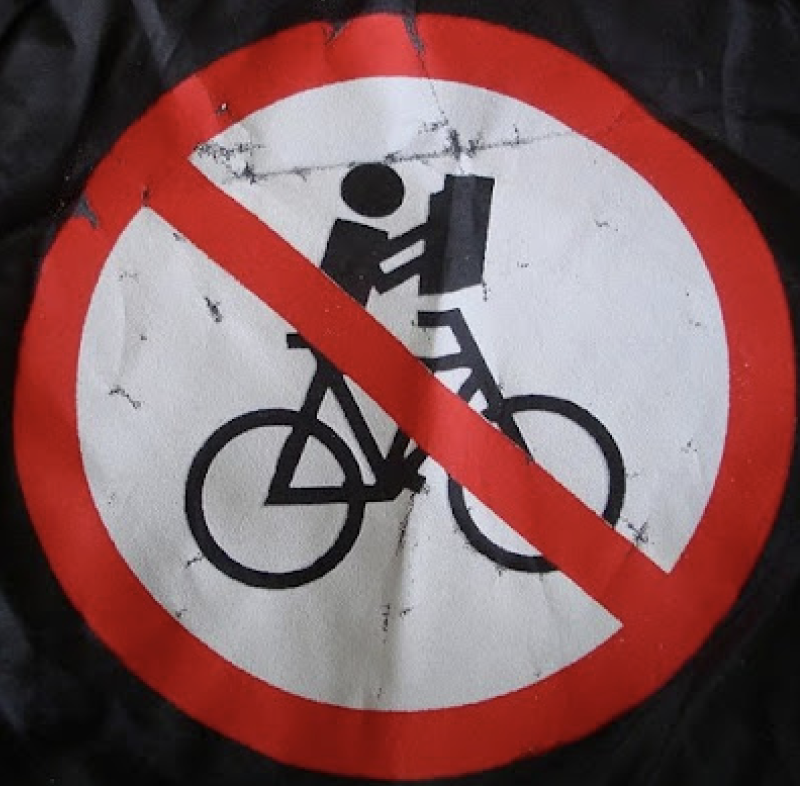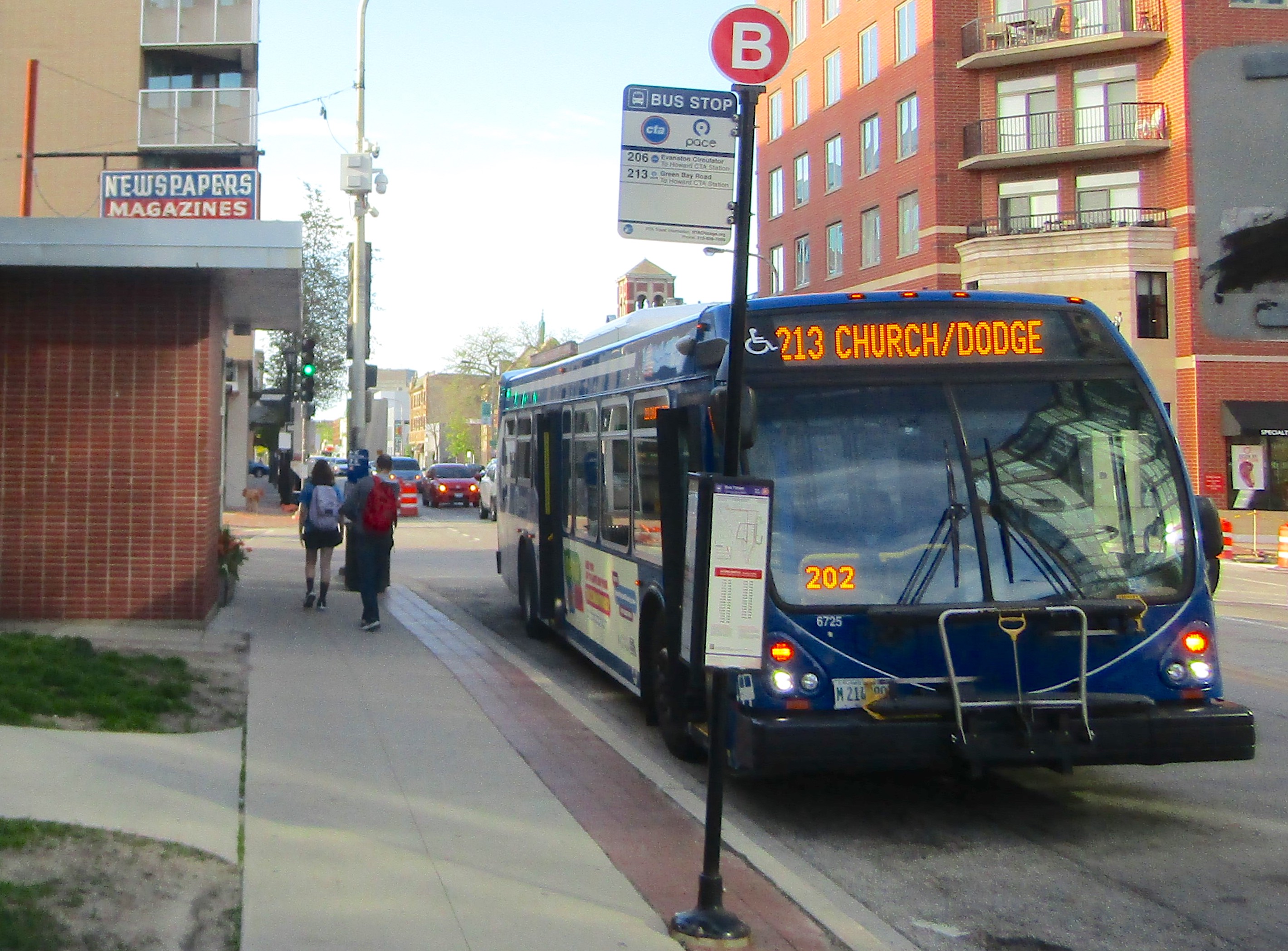Caveat to Lightfoot: Over-police the CTA and you may face NYC-style subway protests
4:37 PM CST on February 3, 2020

Police on New York’s MTA. Photo: Caitlin Plauf via Streetsblog NYC
As we've previously discussed on Streetsblog, the recent wave of violent robberies on the 'L' system is a symptom of Chicago's longstanding economic and racial inequalities. We're never going to come anywhere close to eliminating serious crime on the CTA, or the rest of the city, until we do more to address disparities in housing, education, employment, and healthcare, including mental health and addiction treatment.
That said, the rise in crime on local transit is serious problem that impacts Chicagoans from various walks of life. It's also a sustainable transportation issue because it's likely causing more people to choose car-based transportation out of safety concerns. A recent Chicago Tribune analysis of CPD data found that the number serious crimes — ranging from pickpocketing to robbery and sexual assaults — on the ‘L’ has doubled since 2015, around the time ride-hail launched here.
As reported by the Sun-Times' Fran Spielman, on Friday Mayor Lori Lightfoot discussed another troubling transit crime stats. During the month between Thanksgiving and Christmas, there were 458 criminal incidents on CTA buses and trains, up 24 percent over the same period in 2017. Lightfoot called these numbers "totally, fundamentally unacceptable," adding "We cannot have a circumstance where people are fearful — particularly on the Red Line where the biggest challenge is — of getting on public transportation because we’re not taking the necessary steps to keep the community safe.”
Lightfoot said she's in talks with the CTA and the Chicago Police Department about working together "more cooperatively," the Sun-Times reported. She's also considering adding more foot patrols and security cameras. Last week interim police chief Charlie Beck announced that the responsibility for policing all Chicago public transportation will be placed under the control of a new counter-terrorism unit with "multiple hundreds" of officers, which sounds rather ominous.
"Whatever it takes, we’re gonna turn these numbers around,” Lightfoot told Spielman. However, the mayor should think twice before taking a "by any means necessary" approach to solving the CTA crime problem, because there could be some unintended consequences.
It's possible that adding more cops and cams is the only practical short-term approach for bringing down serious crime numbers on the system. (I've floated the idea of bringing back unarmed civilian conductors, a position that was eliminated in 1998, as a longterm crime deterrent strategy.) But as Streetsblog readers have pointed out, having more officers patrolling the CTA isn't going to make everyone feel safer in a city with well-documented issues with police harassment and violence against Black and Latino residents.
Lightfoot would be wise to look at what's been going on with New York City's Metropolitan Transportation Authority recently. Last year New York governor Andrew Cuomo announced plans for the MTA to spend $250 million to hire 500 more police officers to crack down on fare evasion, an initiative that was projected to save only $200 million in revenue lost to nonpayment. (Here in Chicago, the Active Transportation Alliance has pointed out that a plan to use Metra Police to combat fare evasion on commuter rail would be similar fiscal folly, since there were only 46 arrests for fare evasion on Metra trains between 2016 and 2018.)
Worse, saturating the MTA with cops is likely having the greatest negative impact on New Yorkers of color. Fare evasion should be decriminalized so that the consequences are a ticket, rather than jail time, similar to failure to feed a parking meter -- cities like San Francisco have done just that. As reported by Streetsblog NYC, in the first half of 2019, about 90 percent of people arrested and 70 percent of those cited for nonpayment on the MTA were Black or Brown, which is dramatically higher than ridership numbers for those groups.

Police have also been cracking down on other minor violations on New York transit, often involving people of color. In high-profile cases last November, officers detained and/or handcuffed two different Latina churro vendors.
Moreover, the increase in policing on the MTA has coincided with disturbing cases of brutal behavior by officers. Last October officers pointed their guns inside a train full of commuters before tackling a fare evasion suspect who had his hands up in surrender. Also that month, an officer coldcocked a teen during an altercation on a subway platform.
New Yorkers have responded to the additional policing and harassment with multiple anti-police protests. An action during last Friday's evening rush involved many hundreds of protesters pouring into multiple transit stops, including Grand Central Station, with many participants jumping turnstiles en masse as an act of civil disobedience.
According to a video clip tweeted by the protest group Decolonize this Place, the goals of demonstration were to get cops out of the MTA and end police harassment of people within the system, and to advocate for free transit and making all stations wheelchair accessible. (Some protestors poured Gorilla Glue on turnstiles and scrawled anti-cop slogans on subway station walls and city buses, and one participant lit a smoke bomb in a station -- these are acts that I don't condone.)
We will never know all that happened on #FTP3 on #J31, but we will share what we have come to know. Let us be clear in saying we are in awe of the peoples courage, power and creativity💥We will be rolling out the media all week 🌾 — first few images are by Sophia Guida. pic.twitter.com/pMYw3Mb9wn
— DecolonizeThisPlace (@decolonize_this) February 3, 2020
Assuming mayor Lightfoot follows through with deploying many more police on the CTA, it's going to be crucial for these officers to conduct themselves in a responsible and professional manner and focus on preventing and addressing violent crime. Having more cops in the system shouldn't be an excuse for a crackdown on fare evasion which, as in New York, would largely impact lower-income people of color, essentially punishing residents for being poor.
If the increased police presence helps deter people from illegally smoking on trains, which can impact other riders' health, great. However, judging from what's taken place recently on the MTA, as well as other systems like the San Francisco area's BART, more policing will also likely result in the enforcement of relatively harmless rule-breaking like eating and drinking in train cars, sleeping across multiple seats, and unlicensed vending. And we certainly shouldn't be seeing the police using excessive force against residents on the CTA.
If adding more cops and cams to the CTA in a strategic and disciplined way results in a drop in violent crime, that will be good news. But if the additional policing leads to many more people of color and low-income residents being criminalized, let alone brutalized, don't be surprised if the response is hundreds of angry Chicagoans storming the turnstiles.
In addition to editing Streetsblog Chicago, John writes about transportation and other topics for additional local publications. A Chicagoan since 1989, he enjoys exploring the city on foot, bike, bus, and 'L' train.
Stay in touch
Sign up for our free newsletter
More from Streetsblog Chicago
Elevated Chicago’s new leader on how to build more support for equitable transit-oriented development
Recently announced as executive director Juan Sebastian Arias also shared his POV on Mayor Johnson's Cut the Tape initiative to speed up the development approval process
Since COVID, Pace ridership has fared better on major corridors and in north, northwest suburbs than in south, west ‘burbs
The suburban bus system's top five busiest routes largely maintained their ridership rankings.
Due to incredible support from readers like you, we’ve surpassed our 2023-24 fundraising goal
Once again, the generosity of walk/bike/transit boosters is fueling our reporting and advocacy.




